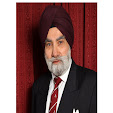Flanked by a “taoos” playing maestro on one side, and a Guiness record holder, tabla player, on the other, it was an unlikely setting at Jalandhar in central Punjab, for world renowned Dya Singh of Australia. For the first time, he was finding himself at a Kirtan smagam, without his motley group of musicians playing a range of East-West musical instrumental blends.
He enthralled the Sangat at this private programme on 1 November, 2011, with classical reets (tunes) reminiscent of great classical ragis like late Bhai Avatar Singh.
Dya Singh had stopped at Delhi for a couple of days on his way to the family home at Ludhiana in Punjab. He was invited by a jatha of Gursikh shardhalus (devotees) to join them on their monthly trip for Sangrand darshan of Darbar Sahib (Golden Temple, Amritsar) on specially booked coaches on the Shtabdi train. The condition for this free ride was simple. “Please do Kirtan taking your turn with other raagi jathas while travelling with us”, That was the request of the organiser. Dya Singh’s host at Delhi agreed readily before he could say a word!
And so it was “Charan chalo marag Gobind.” (With your feet walk the Lord’s path) sung by the whole jatha in three coaches linked by CCTV system. The waves of the divine Sangat Kirtan led by Dya Singh, floated across the farmlands of Haryana and Panjab as the train covered miles of countryside. However, before he reached Ludhiana he had been “persuaded” (Khalsa style) to do a special Kirtan programme for Kirtan devotees at Jalandhar.
He was alone during this Punjab trip, and, so far he is concerned, a stranger in his own country of origin. (He was born in Malaysia.)
And so, Paramjot Singh, who rose to fame by getting his name into the Guiness Book of records for playing tabla continuously for 113 hours, 13 minutes and 13 seconds, and musical teacher specialising in taoos, Sri Pal Singh, came to the rescue. I had covered Paramjot’s record breaking tabla playing story in my UK columns and he is a regular visitor at home in Ludhiana.
Dya Singh mentioned in the introduction, that the “taoos” played by Sri Pal Singh, is a string instrument (like Indian sarangi, only deeper and more melodious), which was made popular by Guru Hargobind Sahib.
So, on 1st November, 2011, the trio found themselves together at Jalandhar Kirtan society’s programme. The deep sound of the taoos filled the environment as the mixed Sangat (Sikhs and, apparently, non-Sikhs) – all Kirtan lovers – listened in deep meditation. Dya Singh’s heart-piercing rendition of Shabad refrain, “Hao reh na saka(n) bin dekhay mery maaee” (I cannot live without the holy sight of my Beloved, O my mother) touched all hearts. I was particularly moved by the classical notes of the taoos and Sri Pal Singh’s soft vocal accompaniment.
Madhwanti Kalyan captured the evening mood. A Shabad, Eh doay naina matt shoho Pir dekhan ki aas” (Touch not these two eyes (a plea to the crows) for I still have hope to see my Beloved Lord) by Bhagat Farid, was a request from an elderly Sikh who came up to the stage.
Paramjot Singh accompanied with sympathetic taal (beat) variety, enhancing the Shabad impact, and excelled in controlled tabla display. During such displays, he alternated effortlessly between deep sounding “mardang” type of beat from a wide-top tabla, and ordinary “kinaar”.
Fortunately the sound quality of the, otherwise amateurish video of this private Kirtan programme, is good. With professional editing this can be Dya Singh’s first successful Kirtan video. I have watched this programme several times on video and wonder, if Dya Singh, an accountant by training, could not have done better by becoming a traditional Kirtania.But then, who else could have taken the universal Message of Sarab Sanjhi Bani to mixed global audiences in Dya Singh’s unique pioneering Sikh world-music style?
Gurmukh Singh UK
E-mail: sewauk2005@yahoo.co.uk
Copyright: Gurmukh Singh
This article may be published with acknowledgement.



Wgkk wgkf
ReplyDeleteThanks for this beautiful article.
but there need a liittle correction of 200 hrs in my record attempt.i.e 313 hrs
thanks and regards